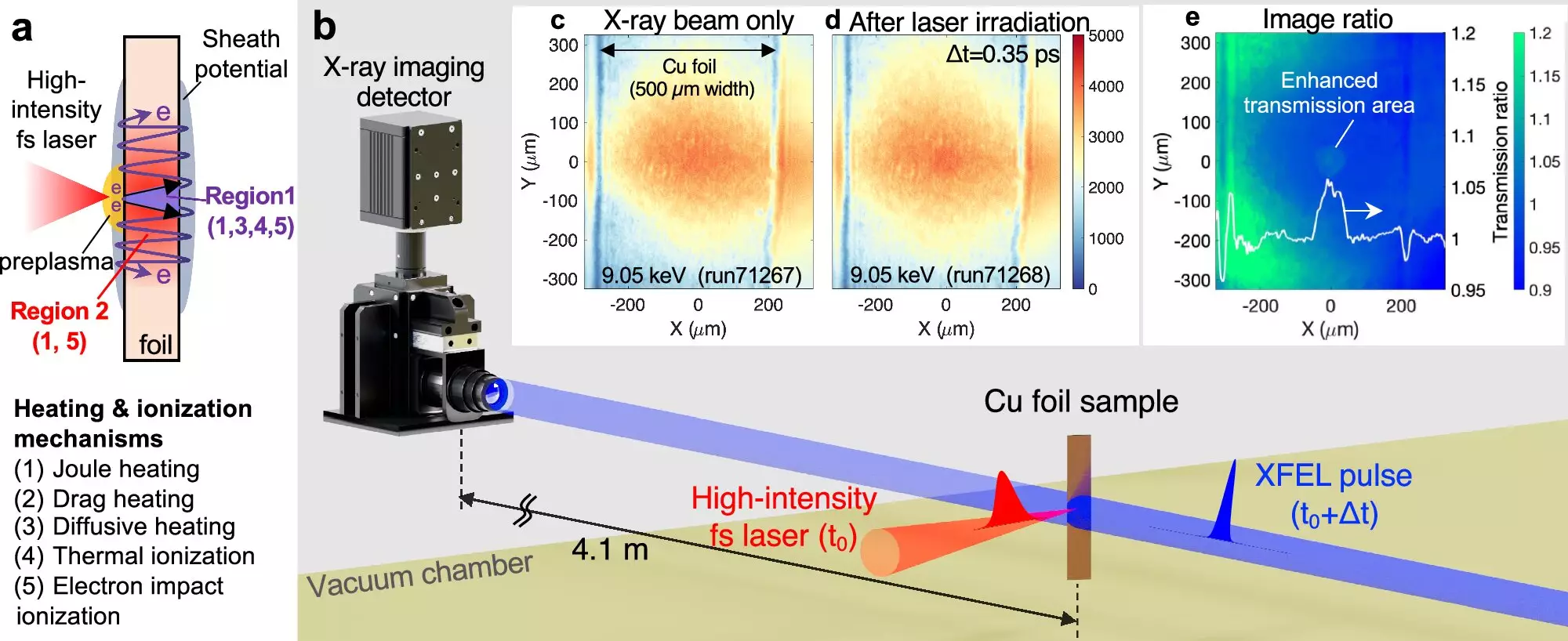The transition of materials from one phase to another is a subject of profound interest in physics, particularly when it occurs at extraordinarily rapid timescales. Recent research has opened new avenues for understanding how a piece of copper can transform into warm dense matter—a state of matter with intriguing properties that has implications for various scientific fields. This phenomenon occurs in an astonishingly brief timeframe, typically within picoseconds (trillionths of a second), marking a crucial intersection of laser technology, materials science, and astrophysics.
When a high-powered laser pulse interacts with a thin piece of copper, the intense energy causes the material to reach a staggering temperature of nearly 200,000 degrees Fahrenheit. This rapid heating propels the copper from a solid state into a plasma state. However, before it fully exits this solid state, it briefly exists as warm dense matter. Understanding the nuances of this phase transition has substantial implications. It can shed light on processes occurring in the interiors of giant planets, as well as improvements to techniques in laser fusion.
Researchers, led by Hiroshi Sawada from the University of Nevada, Reno, have made significant strides in tracking the heating and cooling dynamics of copper under these extreme conditions. Published in *Nature Communications*, their findings highlight innovative methodologies employed to measure the thermal behavior of materials subjected to intense energy bursts.
Central to this groundbreaking research is the use of ultrashort-duration X-ray pulses, generated by the X-ray Free Electron Laser (XFEL) at Japan’s SACLA facility. This cutting-edge technology allows scientists to capture real-time images of temperature changes within the copper after a laser pulse has been applied. By implementing a “pump-probe” technique, researchers can first heat the copper with a potent laser “pump” and subsequently use X-ray pulses to collect data on ionization levels and thermal states—essentially documenting the transition phases of the copper.
This methodology is particularly noteworthy because of its precision. The experiments allowed researchers to analyze heating transitions with micron-scale resolution, a feat that has profound implications for the study of material properties and phase changes. Since a human hair is approximately 70 microns in thickness, this level of detail reveals just how much can happen in exceedingly short timeframes.
The researchers initially anticipated that the copper would transform into classical plasma upon exposure to the laser pulse. Surprisingly, their experiments unveiled that the plasma state observed was instead warm dense matter, raising questions about the previous understanding of such transitions. Overall, the researchers reported an array of unexpected results that challenged existing theories. As Sawada noted, the data collected diverged significantly from the predictions made prior to the experiment, which underscores the unpredictable nature of high-energy density environments.
These revelations not only contribute to our understanding of warm dense matter itself but also emphasize the need for continued refinement of diagnostic techniques used to analyze these states. Because the XFEL operates within a competitive research environment, acquiring beam time can often take years. Therefore, maximizing the output from each experiment is essential, and the team was able to conduct about 200 to 300 shots before the copper samples were consumed.
Sawada envisions that the techniques developed in this study will extend beyond the specific instance of copper and can be applied in a diverse range of physics fields, including astrophysics, inertial fusion energy research, and even quantum physics. By examining how heat transfers within various materials under similar experimental conditions, the research community can explore the influence of structural imperfections on thermal dynamics.
Furthermore, the versatility of XFEL technology means it could pave the way for further advancements in laser-based research methodologies. Potential collaborations with next-generation facilities, such as the MEC-U at SLAC, may yield even more insightful data regarding the behavior of materials under high-energy conditions.
The research conducted on the copper-to-warm dense matter transition marks a pivotal development in our understanding of matter at high-energy densities. By pushing the boundaries of experimental techniques, scientists are uncovering not only the intricate details of material transformations but also developing tools to further explore the unseen processes occurring at the heart of our universe. As methodologies continue to improve, the implications for technology, energy, and our understanding of fundamental physical principles will likely be profound, enriching both the scientific community and society at large.


Leave a Reply